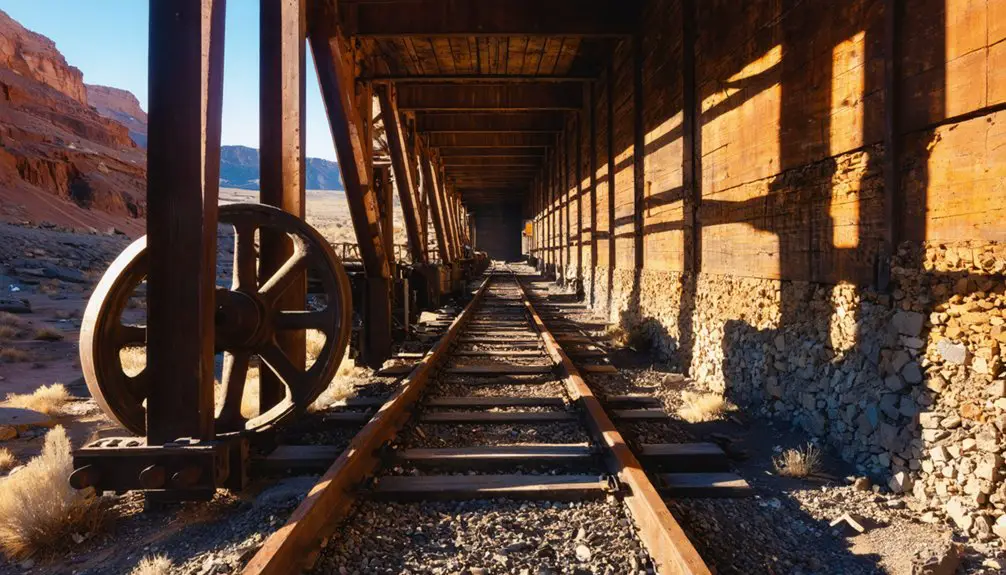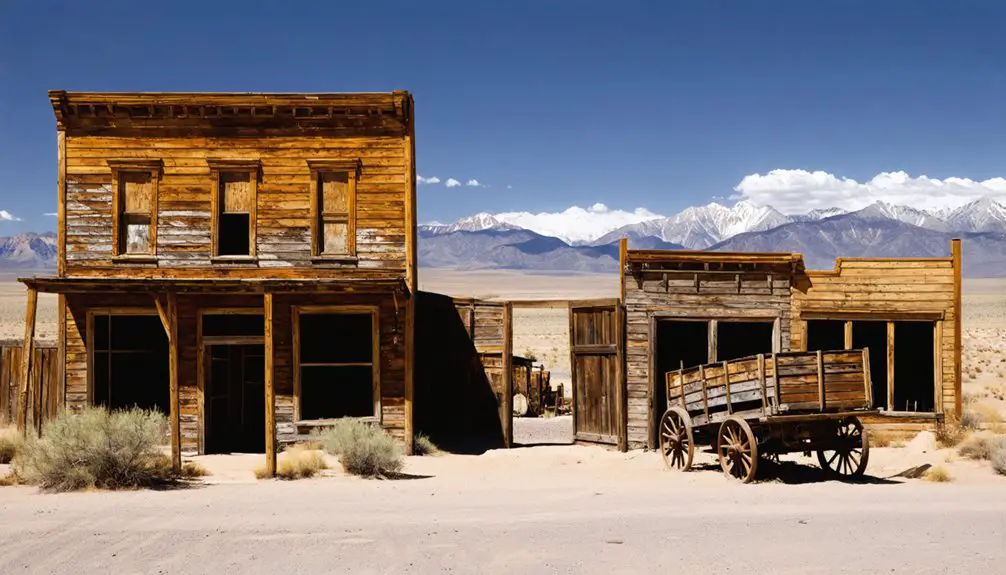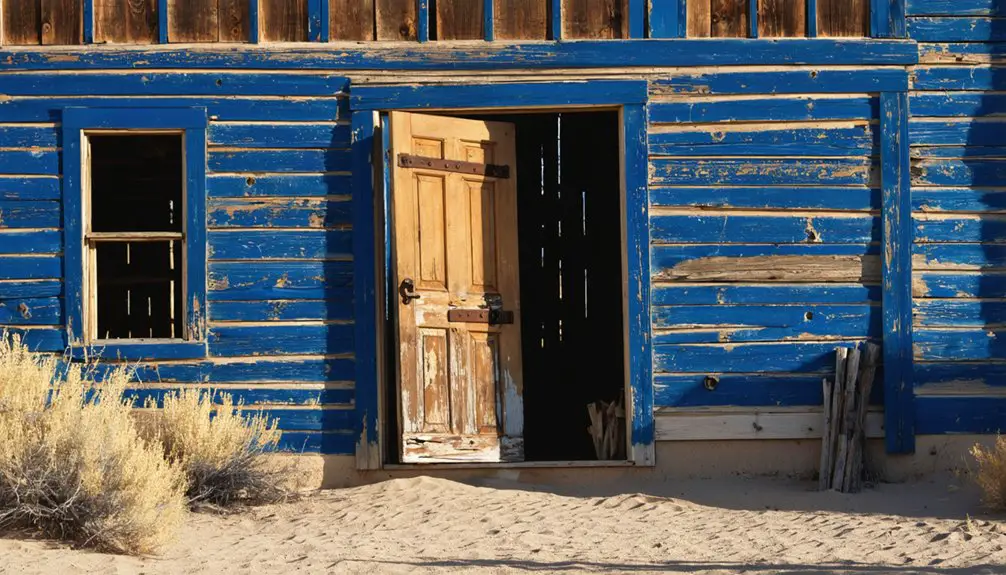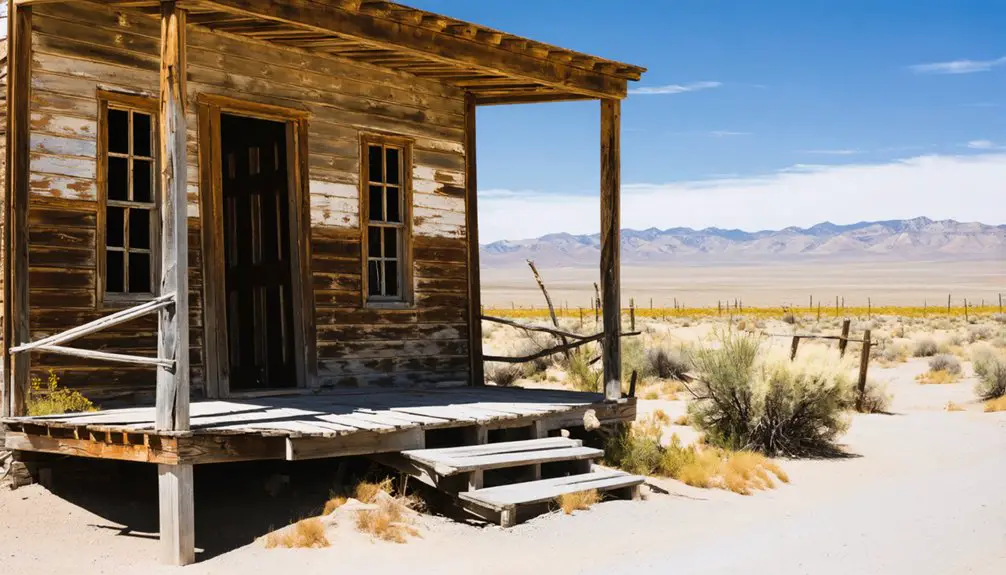You’ll find Johnnie’s story begins in 1891 when Paiute guide “Indian Johnnie” led the Montgomery brothers to rich gold deposits in Nevada. The settlement grew from a modest mining camp to a bustling boomtown of 350 residents by 1907, complete with stores, saloons, and a post office. While mining operations continued sporadically until 1960, the site’s estimated $10 million gold yield and tales of the Lost Breyfogle Mine still draw curious explorers to this historic ghost town.
Key Takeaways
- Johnnie began as a gold mining settlement in 1891 after Paiute guide “Indian Johnnie” led prospectors to rich deposits.
- The town peaked between 1905-1907 with 350 residents, featuring stores, saloons, hotels, and a post office.
- Mining operations included the Johnnie Mine, Congress Mine, and Labbe Mine, with a 16-stamp mill processing ore.
- The Johnnie Consolidated Milling and Mining Company controlled nearly 183 acres and processed thousands of tons of ore.
- Mining operations continued sporadically until 1960, when the town was abandoned and achieved ghost town status.
The Birth of a Mining Camp
When a Paiute guide known as “Indian Johnnie” led the Montgomery brothers to a rich gold site in 1891, the mining camp of Johnnie emerged in Nye County, Nevada. The Paiute influence on this discovery proved essential, as the area had long been rumored to contain the legendary Lost Breyfogle Mine dating back to 1863.
Initially named Montgomery, the settlement quickly adopted the name Johnnie after the Native American guide and the nearby Johnnie Mine. By 1895, the camp featured a stamp mill operation where miners processed their ore.
You’ll find the camp was established northeast of the mine site, with the Congress Mine (also known as Chispa) supporting its growth. The gold discovery prompted swift development, bringing roughly 100 miners to work the claims. Several wooden cabins still remain at the site today, though they are located on private property and not accessible to the public.
Tales of the Lost Breyfogle Mine
The mysterious tale of the Lost Breyfogle Mine began in 1863 when Joshua Breyfogle stumbled upon a rich quartz ledge near Austin, Nevada, while fleeing from an Indian attack in Death Valley.
For the next 26 years, you could have found Breyfogle searching tirelessly for the rich deposit, but his somewhat impaired mental state after the attack made the quest increasingly difficult.
After his rescue, he organized numerous search parties and spent twenty-six years exploring the region northeast of Death Valley.
The Breyfogle Mystery has captivated treasure hunters for generations, spawning numerous expeditions into the Death Valley region.
Even experienced miners like Wildrose Kennedy attempted to locate the site using indigenous maps, but the mine’s true location remains elusive.
While the search for Breyfogle’s lost discovery continues, it inadvertently led to other significant finds, including the Johnnie Mine in 1891, which would eventually yield an estimated ten million dollars in gold throughout its operations.
Peak Years and Town Development
You’ll find Johnnie’s peak prosperity occurred between 1905-1907, when the population swelled to nearly 350 residents amid renewed mining investment and operations at the Congress Mine.
The town’s development reflected its success through multiple stores, saloons, hotels, and infrastructure improvements including fire hydrants and tree-lined streets. Post office services first began when the post office opened in 1905. Labor issues eventually took their toll as labor disputes in 1899 forced operations to temporarily cease.
Mining operations expanded with a 16-stamp mill at the Johnnie Mine, while stage lines and a reopened post office supported the growing community’s commercial needs.
Population Growth and Prosperity
During Johnnie’s peak years between 1905 and 1914, prosperity transformed this Nevada mining settlement into a bustling community of 300-350 residents.
The population dynamics reflected the town’s economic fluctuations, with new mineral discoveries in 1905 attracting fresh waves of miners and entrepreneurs. You’d have found a well-developed townsite complete with stores, saloons, hotels, and restaurants serving the growing population. The town relied heavily on mule train transport to bring in essential supplies from distant stations.
The community’s infrastructure expanded to include modern amenities like fire hydrants and cold water, while tree-lined streets gave the frontier town a more established feel.
A 16-stamp mill supported the mining operations, providing steady employment and driving the local economy. This golden age marked Johnnie’s most stable period, though it would prove relatively short-lived as mining activity began declining by 1914.
Town Services and Amenities
As Johnnie’s population swelled, an extensive network of services and amenities emerged to support daily life in this frontier mining town.
You’d find a bustling business district with stores, saloons, restaurants, and hotels serving hundreds of residents and visiting prospectors. Community services centered around the post office, which operated intermittently from 1891 to 1935.
Urban planning efforts brought significant infrastructure improvements between 1905-1907. You could see shade trees lining the streets, and the installation of fire hydrants and cold water systems replaced the earlier method of transporting water by donkey from springs four miles away.
The 16-stamp mill at Johnnie Mine and regular stage line service connected the town to regional commerce, while multiple saloons provided social gathering spaces for the mining community.
Mining Industry Drives Growth
While gold was initially discovered in the Johnnie Hills around 1891, the town’s true mining boom didn’t materialize until 1905 when new discoveries sparked intense development.
The reopening of the Congress Mine and staking of new claims transformed Johnnie from a modest camp into a bustling hub of mining prosperity, with the population swelling to 350 by 1907.
You’ll find evidence of both hard rock and placer mining operations that sustained the town through its peak years. Sample values from placer deposits yielded impressive returns of $6 to $30 per cubic yard.
The area became part of the established Johnnie Mining District in Mount Montgomery, which was renowned for its rich mineral deposits.
Miners employed various techniques, from traditional shaft mining to the innovative Mexican Air Jig for processing gold-bearing gravels.
Though mining activity continued sporadically until 1960, the decline in profitability after 1914 gradually led Johnnie toward its current ghost town status, leaving behind abandoned mines and stone foundations as proof of its golden era.
Mining Operations and Technology

The mining operations at Johnnie began with basic prospecting tools but quickly expanded to include a 16-stamp mill by 1895 to process gold-bearing quartz from the Congress Mine.
You’ll find evidence of both hard rock mining methods for extracting quartz veins and placer mining techniques, including dry washing operations that were essential in this arid region.
The district’s mines featured multiple underground shafts and tunnels, with the Johnnie Mine, Congress Mine, and Labbe Mine representing the major extraction points where miners worked the relatively shallow gold veins.
Mining Equipment and Methods
Mining operations in Johnnie evolved from primitive hand tools to sophisticated mechanical systems throughout its history. Early mining technologies relied heavily on picks, shovels, and black powder for initial ore extraction. As operations expanded, you’d have seen the introduction of mechanical drills and dynamite in the late 1860s, dramatically improving excavation methods underground. The miners also utilized hydraulic monitors to excavate surface deposits more efficiently.
- You’ll find evidence of square-set timbering techniques from 1860, which prevented deadly cave-ins and allowed miners to venture deeper.
- Wire rope systems replaced dangerous hemp ropes and iron chains, revolutionizing the hoisting of ore from deep shafts.
- Stamp mills crushed hard rock ore while early smelting operations, like those using the Arenh siphon tap, extracted precious metals more efficiently.
These advancements transformed Johnnie from a simple prospecting site into a more sophisticated mining operation.
Early Stamp Mill Operations
Powered by massive stamps crushing gold-bearing quartz ore, Johnnie’s early milling operations centered around a prominent 16-stamp mill that operated at the Johnnie Mine throughout the early 1900s.
The stamp mill technology proved essential for processing ore from the 182.91 acres controlled by the Johnnie Consolidated Milling and Mining Company.
You’ll find the milling infrastructure was quite sophisticated for its time, with water piped from Horseshootem Springs to storage tanks that supported the ore processing.
The operation included ore bins, hoist houses, and cook houses to maximize efficiency.
When Los Angeles investors Carl Schader and T.A. Johnson acquired the property in 1903, they expanded the milling capabilities.
While labor disputes in 1898 temporarily disrupted production, the mill continued to process thousands of tons of ore through the early 1910s.
Underground Shaft Development
During the early 1890s, prospectors sank their first shafts into Johnnie’s gold-bearing quartz veins, establishing what would become an extensive network of underground workings.
The shaft engineering evolved from simple vertical passages to sophisticated timbered structures reaching hundreds of feet deep. You’ll find evidence of both steam-powered hoists and hand-operated windlasses that miners used to transport ore and workers through these shafts.
- Dark passageways lit only by carbide lamps revealed glinting gold in exposed quartz
- Timber-lined shaft walls stood as silent guardians against cave-ins
- Each level branching from the main shaft told stories of miners’ determination
Mining safety remained an ongoing challenge, with flooding, unstable rock, and poor ventilation threatening operations.
Despite these obstacles, technological advances in drilling and pumping equipment allowed miners to push deeper into Johnnie’s rich veins.
Life in the Boomtown Era

When gold was discovered in early 1891, Johnnie quickly transformed from an empty desert landscape into a bustling frontier community.
Within months, over 100 residents had established homes, and by 1907, you’d find up to 350 people going about their daily routines in this desert outpost.
From a barren desert to a thriving community of 350 souls, Johnnie’s rapid growth exemplified the transformative power of frontier gold.
You’d experience a town equipped with modern amenities like fire hydrants and tree-lined streets. The post office served as a hub for community events, while saloons and restaurants offered places to unwind after long days in the mines.
Families made their homes here, creating a vibrant social atmosphere despite the harsh mining environment. Stage lines connected you to neighboring towns, bringing fresh supplies and new faces.
While labor disputes sometimes disrupted the peace, Johnnie’s residents maintained a strong sense of community until mining declined in 1914.
Struggles and Labor Disputes
Although gold brought prosperity to Johnnie, violent labor disputes tore at the fabric of the mining community. The late 1890s saw intense labor violence erupt between mine owners and workers, resulting in deadly gun battles, burned buildings, and dynamited structures.
After Utah capitalists purchased the mines in 1898, union struggles intensified as owners attempted to break union power through strategic wage cuts and threats to import non-union labor.
- Gun battles left one man dead and three wounded in a single confrontation
- Workers retaliated by burning the cookhouse and 10-stamp mill
- Rival unions WFM and IWW weakened worker solidarity through internal conflicts
The labor strife eventually required government intervention, with federal troops maintaining order in nearby mining districts.
These ongoing conflicts contributed greatly to Johnnie’s operational decline and ultimate abandonment by 1914.
The Path to Abandonment

Despite initial prosperity from gold discoveries in 1891, Johnnie’s path to abandonment unfolded through a series of boom-and-bust cycles over three decades.
Like many Western gold towns, Johnnie’s brief golden age gave way to repeated cycles of hope and disappointment spanning thirty years.
You’ll find the major abandonment factors included shallow ore veins that quickly depleted, persistent labor disputes, and unstable operations that deterred investors.
The town’s ghost town evolution occurred in distinct phases. After the first exodus in 1899, a brief revival in 1905 brought the population to 350, complete with modern amenities like fire hydrants and tree-lined streets.
By 1914, you’d have found fewer than 15 residents remaining. The final chapter closed when the post office shuttered in 1935, and post-World War II private land purchase sealed Johnnie’s fate.
Today, you’ll need permission to visit the sparse remnants of this once-bustling mining community.
Ghost Town Legacy Today
Through a generous land donation to the Pahrump Valley Museum, Rulon and Lisa Bunker have preserved several historic mines at Johnnie, including the April Fool, Johnnie, Teddys, and Teddys Terror mines.
This significant ghost town preservation effort protects 242 acres of historic mining landscape while prohibiting future mining activities to maintain its authenticity.
Today, you’ll find a landscape that tells the story of Nevada’s mining heritage:
- Scattered rock foundations and wooden fragments mark where a thriving community of 300 once lived
- Dozens of deep mine adits await proper fencing before public access can begin
- Wild horses and burros now roam freely among the ruins, reclaiming the desert landscape
While tourism potential remains untapped, the museum’s future plans include cabin restoration and interpretive programs to showcase authentic mining life experiences.
Frequently Asked Questions
What Temperatures and Weather Conditions Did Miners Face in Johnnie Year-Round?
You’d face extreme temperatures ranging from freezing winters at 25°F to scorching summers over 100°F, with seasonal weather bringing rare snow, sudden thunderstorms, and dusty winds through mostly clear, dry days.
Were There Any Significant Archaeological Artifacts Discovered in Later Excavations?
You won’t find documented archaeological findings from formal excavations at this site. While historical artifacts likely exist, modern mining activities and disturbances have prevented systematic study of the area’s material remains.
How Did Mail Delivery and Communication Systems Operate in Remote Johnnie?
Like a lifeline through the desert, you’d rely on daily stagecoach mail routes to Amargosa Station, while donkey-carried water bags and mining offices served as makeshift communication methods until 1914’s final closure.
What Indigenous Cultural Sites Existed in the Area Before Mining Began?
You’ll find ancient hunting mounds, pit-houses, and rock wall enclosures from Northern Paiute and Washoe tribes, who left petroglyphs marking their Native Heritage. These Cultural Preservation sites reveal extensive pre-mining indigenous life.
Did Any Famous Outlaws or Notorious Characters Ever Visit Johnnie?
You won’t find evidence of famous outlaws or notorious characters visiting here. Historical records focus on mining disputes and labor issues rather than criminal activity in this remote desert camp.
References
- https://www.nevadaappeal.com/news/2017/oct/13/legends-of-johnnie-and-the-lost-breyfogle-mine/
- https://www.desertusa.com/desert-activity/nevada3.html
- https://www.legendsofamerica.com/nv-deathvalleyghosttownnevada/
- https://www.youtube.com/watch?v=XXcfMWx5c98
- https://www.youtube.com/watch?v=DcrHdRNfPOk
- https://www.mindat.org/locentry-285099.html
- https://pvtimes.com/news/johnnie-mines-donated-to-museum/
- https://www.desertusa.com/dusablog/charles-breyfogle-and-his-lost-mine/
- https://digital-desert.com/death-valley-trails/loafing-along/chapter-22.html
- https://www.ghosttowns.com/states/nv/johnnie.html



